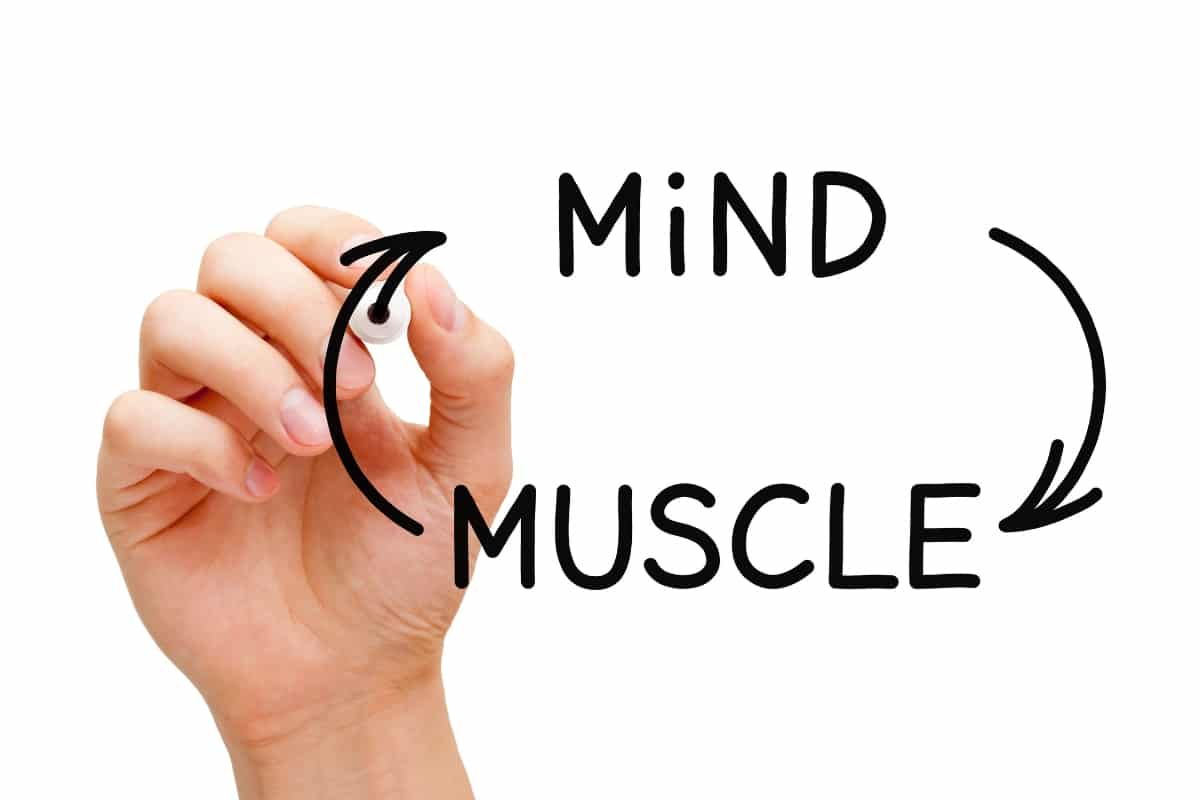
Mind to Muscle Connection: What is it and How to Improve it
Do you feel like you’re lifting weights, but your muscles aren’t listening? Introducing the game-changer for natural bodybuilders: the mind-muscle connection.
This powerful technique can revolutionize your training, taking your gains from good to great without a single steroid in sight.
The Essence of Mind-Muscle Synergy
At its core, mind-muscle connection is about focus and intention. It’s the bridge between thought and action, turning each rep into a targeted sculpting tool.
By harnessing this link, you unlock your body’s potential for precision and growth.
Why Ignite Your Mind-Muscle Link?
Imagine each exercise with laser-like precision, where every movement is a conversation with your body. Enhancing this communication doesn’t just improve form; it maximizes hypertrophy, reduces injury risk, and elevates your workout efficiency. It’s a natural path to that coveted definition and strength.
Building the Connection: Strategies for All Levels
There are ways to improve your neuromuscular rapport whether you’re new to the gym or a seasoned pro. Your silent muscles can come to life with simple changes in how you focus and train.
When you repeat something with purpose, it’s not just going through the motions; it turns into a conversation that gets results.
Start your Mind-Muscle Journey
Are you ready to make this important link? Explore the world of cognitive muscle engagement and see how it can change your life. Our guide is full of useful tips that will help you focus better and keep it up. To really work your muscles, you need to make every rep count. Believe in the power of your mind, and your muscles will do the same. Start incorporating muscle memory techniques into your workouts to build consistent and lasting progress. These techniques help train your body to perform movements with precision and efficiency, making each session more impactful over time. With dedication and the right mindset, you’ll soon find yourself achieving goals you once thought were out of reach.
Important Facts About the Link Between the Mind and Muscle
- To connect your mind to your muscles, you have to pay attention to the muscle you are engaging.
- It has to do with consciously tightening muscles while working out.
- For improvement, you need to practice, picture what you want to achieve, and move slowly and carefully.
- One technique is to close your eyes to help you concentrate and keep your form right.
Benefits of The Mind-to-Muscle Connection
- For better workouts, it makes muscles work harder.
- improves the quality of each exercise, which makes sessions more effective.
- helps muscles grow by focusing on and isolating certain muscle groups.
- Lowers the risk of getting hurt by encouraging controlled movements and good form.
- It makes the neuromuscular system work better, which makes movements smoother and more natural.
Pros and Cons of Implementing Mind to Muscle Connection
Pros:
- Helps you focus, which makes your exercises more accurate.
- Increases muscle engagement for better gains.
- It makes you more aware of your body, which is good for improving your overall fitness.
Cons:
- Needs mental effort and can be mentally draining for some people.
- As the focus shifts to form overload, the total amount of weight lifted may go down.
- Beginners might find it hard to get established without help.
How the Mind and Muscles Are Connected
Mind to muscle connection, which is also known as neuromuscular focus, means focusing on the muscle you’re working out. To do this, you need to connect your brain to the muscle fibers you want to stretch. Focus is very important.
How to Improve Neuromuscular Focus Step-by-Step
To improve the connection between your mind and muscles, follow this complete plan that stresses focus, form, and the right way to breathe during exercises:
| Exercise | Sets | Reps | Rest Interval | Focus Point |
|---|---|---|---|---|
| Bicep Curls | 4 | 12 | 60 seconds | Squeeze the biceps at the top of each curl. |
| Leg Press | 4 | 10 | 90 seconds | Push through the heels, focus on contracting quads. |
| Chest Flys | 3 | 15 | 75 seconds | Imagine hugging a tree to maximize chest contraction. |
Focus on doing each rep slowly and with purpose, and visualize the muscle fibers contracting and extending. Keep your breathing in check to stay on task.
Avoiding Common Mistakes
Some mistakes that people often make are rushing through reps or getting distracted. Get rid of anything that might be distracting you and do exercises in front of a mirror to see how your muscles work. Don’t lift too much; a lighter weight with good form makes the connection stronger.

Personal Insights on Mind to Muscle Mastery
“Slowing down my reps and visualizing the muscle contracting completely changed my training,” says a friend of mine who is also a personal trainer. “It’s a game-changer for growth.” Reflecting on your experiences can confirm the effectiveness of this training method.
How can you keep your intensity and focus?
1. Start with a warm-up to get your CNS (central nervous system) working.
2. Visualize yourself doing each rep before you do it.
3. To make yourself more aware, touch or tap the muscle you’re working before you start a set.
4. Keep your breathing steady and aware during all of your sets.
5. Do a cool-down at the end of each workout to think about how your muscles were worked.
New methods for engaging neural networks
Use these strategies to improve neural engagement. Pre-activation drills make you more aware of your muscles.
Focus on doing fewer reps more slowly to boost your neural drive. Keep track of your lifts. Neuromuscular proficiency is improved by visual feedback.
Customization for a Range of Fitness Goals
Change how you recruit neurons to hit your goal. For heavy lifts, you need to keep a very close eye on the prime movers. On the other hand, sculpting uses a controlled speed to make muscles more aware. Pick a strategy that fits with your fitness goals.
Integrating Diverse Practices for Synergy
Neuromuscular connection works best when used with other methods. It can be used with periodization to change the intensity. For better kinaesthetic sense, you might want to try yoga. This kind of integration leads to better body composition results.
Pillars of Nutrition and Healing
The best nutrition and recovery are very important. There are building blocks for muscle repair that are proteins. Mindfulness or meditation can help the central nervous system feel better. These things are very important for a strong neuromuscular bond.
Thoughts from Mind-Muscle Experts
Experts say that you should have intent during each rep. One Dr. says, “Imagine your muscles getting bigger and smaller.” This kind of visualizing makes muscles contract. For advanced muscle activation, use tips from seasoned professionals.
Pay attention to mobility and stability work
Motor patterns run more smoothly when joints are flexible. So, make mobility exercises a regular part of your life. In turn, stability work makes neuromuscular control better. Putting these things together makes muscle synchronization much better.
Adding Progressive Overload to It
The key is to methodically increase the stress of training. With each session, the muscles have to be focused on something different. It is possible to make big hypertrophic changes by slowly adding weight while keeping your neuromuscular awareness high.
Final Thoughts on Improving Neural Engagement with your Muscles
A key part of training that makes your workouts more effective is connecting your mind to your muscles, also known as neural engagement with your muscles. Focusing on activating specific muscle groups will help you recruit more muscle fibers, which will improve your strength and cause your muscles to grow bigger.
This attention to detail not only lowers the risk of injury, but it also gives every movement a purpose, which makes the benefits even greater.
Focus on this connection for each rep, and you should see a change in both your performance and the way your muscles look. Don’t forget that effective training isn’t just doing the moves; it’s about making sure that every lift is done with purpose.
Now, take these tips and use them every time you go to the gym. You’ll see results that show how dedicated you are.
FAQs
What does the mind-muscle connection really mean?
The mind-to-muscle connection is when you consciously and focusedly work out a specific muscle group during resistance training. This makes the muscle group more active and the exercise more effective.
Can making this connection stronger really help muscles grow?
Yes, focusing more on the muscle being worked can make muscle fibers recruit more, which could lead to better strength gains and muscle growth over time.
Is the mind-muscle link only helpful for experienced athletes or also for beginners?
This method works well for all skill levels. It might help beginners learn how to move quickly, and it can help more experienced athletes improve their training.
Does this technique make my workouts take longer?
Workouts may go more slowly at first as you focus on form and muscle engagement, but this usually leads to better sessions in the long run.
What are some signs that I’m connecting my mind to my muscles?
The muscle you want to work should feel like it’s working harder. You may also notice better muscle control and faster muscle growth in that area over time.
Are there specific exercises that help the mind and body work better togheter?
When you do exercises that work just one muscle at a time, like bicep curls or leg extensions, it’s often easier to focus on working the target muscle and making this connection stronger.
How often should I use this technique when I work out?
Try to use this technique for every exercise during every workout. Consistency is key to mastering the mind-muscle connection and getting the most out of it.
Can mind-to-muscle exercises help keep you from getting hurt?
You can improve your form and possibly lower your risk of injury during workouts by becoming more aware of how your body is positioned and how you control your muscles.
Should I picture the muscle working to make the connection stronger?
It is true that visualization is a strong tool. Imagine the muscle fibers tightening and loosening up. This can help strengthen the link between your mind and the muscle.
Can this method be used with other methods of training?
Yes, of course. It can help you get fitter in many ways when you combine it with other methods like progressive overload and periodization.



